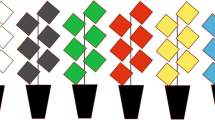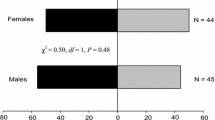Abstract
Phytophagous insects select their host plant using multiple sensory modalities including vision, olfaction, gustation and mechanoreception. In the laboratory, we investigated the role of vision, olfaction and gustatory sense in the perception of cues released by seeds of different plant species in granivorous Coreus marginatus (Heteroptera: Coreidae). Juvenile insects were put in a choice arena and offered with different seeds on which they feed naturally (Polygonum, Rumex) and seeds which are not their natural food (Stellaria). Individual bugs were manipulated in one of three ways: 1. blackened compound eyes, 2. coated sensillae on antennae, 3. coated tip of labial pouch. Control individuals were not manipulated. The behaviour of each bug was observed for 12 h. Control bugs fed for a significantly longer time than manipulated ones. Individuals with any senses impaired fed on Stellaria, whereas, the control individuals ignored it. The results suggested that seed selection requires information from all three sensory organs: compound eyes, antennae and sensillae on labial pouch. Further research is required to unravel the importance of each sense for the seed selection.



Similar content being viewed by others
References
Ambrose DP, Samuel M, Sahayaraj K (1991) Impact of antennectomy, eye blinding and fossula spongiosa coating on the predatory behaviour of Acathaspis siva Distant (Heteroptera: Reduviidae: Acathaspidinae). J Adv Zool 12(1):37–44
Awan MS, Wilson LT, Hoffmann MP (1989) Prey location by Oechalia schellembergii. Entomol Exp Appl 51:225–231
Bruce TJA, Wadhams LJ, Woodcock CM (2005) Insect host location: a volatile situation. Trends Plant Sci 10(6):269–274
Carver M, Gross GF, Woodward TE (1991) Hemiptera. In: CSIRO Staff (eds) The Insects of Australia, vol I, 2nd edn. Melbourne University Press, Melbourne, pp 429–509
Chapman RF (2003) Contact chemoreception in feeding by phytophagous insects. Annu Rev Entomol 48:455–484
Chinta S, Dickens JC, Aldrich JR (1994) Olfactory reception of potential pheromones and plant odors by tarnished plant bug, Lygus lineolaris (Hemiptera: Miridae). J Chem Ecol 20(12):3251–3267
Cook CA, Neal JJ (1999) Plant finding and acceptance behaviors of Anasa tristis (DeGeer). J Insect Behav 12(6):781–799
Crawley MJ (2002) Statistical computing. An introduction to data analysis using S-Plus. Wiley, Chichester
Drukker B, Sabelis MW (1990) Anthocorid bugs respond to odour emanating from Psylla infested pear trees. Proceedings of the Experimental & Applied Entomology, N.E.V. Amsterdam 1:88–89
Evans H (1984) Insect biology: a textbook of entomology. Addison-Wesley, Reading
Freud RL, Olmstead KL (2000) Role of vision and antennal olfaction in habitat and prey location by three predatory heteropterans. Environ Entomol 29(4):721–732
Hrušková M, Honěk A (2001) Development of Coreus marginatus (Heteroptera: Coreidae) fed on seeds of Rumex obtusifolius. Acta Soc Zool Bohem 65:189–195
Hrušková M, Honìk A, Pekár S (2005) Coreus marginatus (Heteroptera: Coreidae) as a natural enemy of Rumex obtusifolius (Polygonaceae). Acta Oecol 28(3):281–287
Huignard J, Dupont P, Tran B (1990) Coevolutionary relations between bruchids and their host plants: the influence on the physiology of the insects. In: Fujii K, Gatehouse AMR, Johnson CD, Mitchell R, Yoshida T (eds) Bruchids and legumes: economics, ecology and coevolution.d Kluwer, Dordrecht, pp 171–179
Hulme PE, Benkman CW (2002) Granivory. In: Herrera CM, Pellmyr O (eds) Plant–animal interaction. Blackwell Science, Oxford, pp 132–154
Korcz A (2001) Heteroptera occurring on Achillea milefolium L. J Plant Prot Res 41(4):378–387
Krutov VV, Sinitsina EE (1995) Development of artificially induced food preferences in the bug Podizus maculiventris Say. Moscow Univ Biol Sci Bull 50(4):36–42
Lucas E, Alomar O (2002) Impact of the presence of Dicyphus tamaninii Wagner (Heteroptera: Miridae) on whitefly (Homoptera: Aleyrodidae) predation by Macrolophus caliginosus (Wagner) (Heteroptera: Miridae). Biol Control 25(2):123–128
Mattson WJ (1986) Competition for food between two principal cone insects of red pine, Pinus recinosa. Environ Entomol 15:88–92
Putshkov VG (1962) Krajoviki. Fauna Ukrajini 21. Vydavnictvo AN Ukrainskoi RSR. Kiev. Vip. 2. (in Ukrainian)
R Development Core Team (2004) R: a language and environment for statistical computing. R Foundation for Statistical Computing Vienna, Austria. Available at http://www.R-project.org
Rani PU, Madhavendra SS (1995) Role of sensory receptors in the prey selection behaviour of Eocanthecona furcellata Wolf (Heteroptera-Pentatomidae): a predator of phytophagous insects. Phytophaga 7:147–156
Richards AM, Filewood LW (1990) Feeding behavior and food preference of the pest species comprising the Epilachna vigintioctopunctata (F.) (Coleoptera, Coccinelidae). J Appl Entomol 110(5):501–515
Sant’Ana J, da Silva RFP, Dickens JC (1999) Olfactory reception of conspecific aggregation pheromone and plant odors by nymphs of the predator, Podisus maculiventris. J Chem Ecol 25(8):1813–1826
Schooley RL, Wiens JA (2003) Finding habitat patches and directional connectivity. Oikos 102(3):559–570
Scutareanu P, Drukker B, Bruin J, Posthumus MA, Sabelis MW (1997) Volatiles from Psylla-infested pear trees and their involvement in attraction of athocorid predators. J Chem Ecol 23(10):2241–2260
Sinitsina EE, Krutov VV (1996) Antennal and labial sense organs in a bug Podizus maculiventris (Hemiptera, Pentatomidae). Zoologitcheskij Zhurnal 75(8):1167–1173 (in Russian)
Sinitsina EE, Chaika SY (1998) Sensory apparatus of antennae in terrestrial bugs (Heteroptera). Zool Zh 77(11):1273–1284 (in Russian)
Tol van RWHM, Visser JH (2002) Olfactory antennal responses of the vine weevil Otiorhynchus sulcatus to plant volatiles. Entomol Exp Appl 102(1):49–64
Torres M, Cardenas E, Perez S, Morales A (2000) Haematophagy and cleptohaematophagy of Clerada apicicornis (Hemiptera: Lygaeidae), a potential biological control agent of Rhodnius prolixus (Hemiptera: Reduviidae). Mem Inst Oswaldo Cruz 95(1):131–133
Ventura MU, Montalván R, Panizzi AR (2000) Feeding preferences and related types of behaviour of Neomegalotomus parvus. Entomol Exp Appl 97:309–315
Acknowledgements
SP was supported by project no. 0002700601 provided by the Ministry of Agriculture, Czech Republic and MH was supported by grant no. 524/05/4536 of the Grant Agency of the Czech Republic.
Author information
Authors and Affiliations
Corresponding author
Additional information
Editorial responsibility: R. Oliveira
Rights and permissions
About this article
Cite this article
Pekár, S., Hrušková, M. How granivorous Coreus marginatus (Heteroptera: Coreidae) recognises its food. acta ethol 9, 26–30 (2006). https://doi.org/10.1007/s10211-006-0011-9
Received:
Revised:
Accepted:
Published:
Issue Date:
DOI: https://doi.org/10.1007/s10211-006-0011-9




